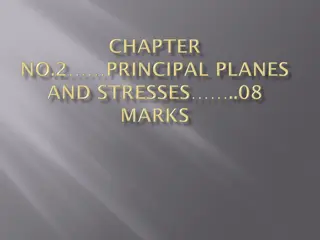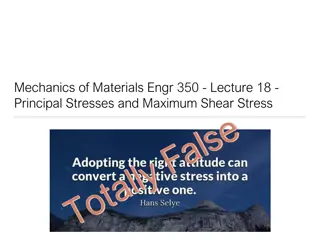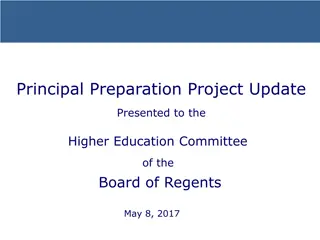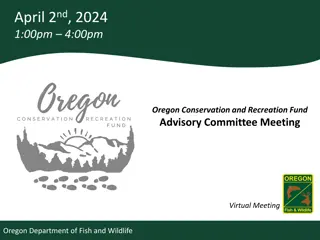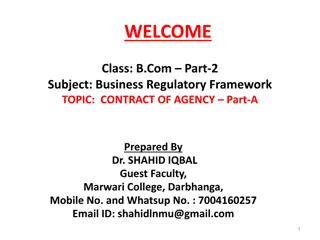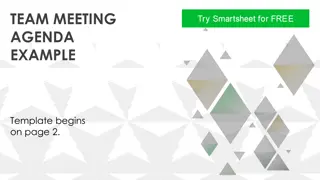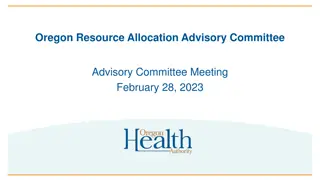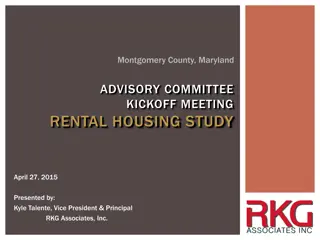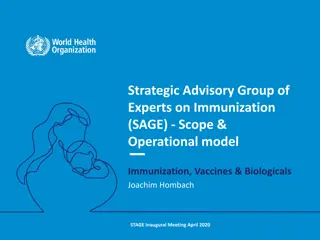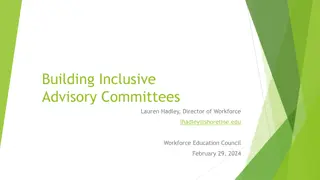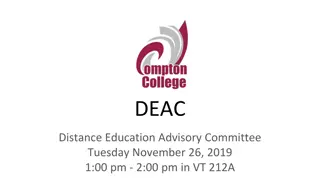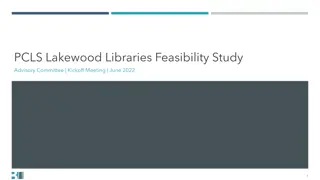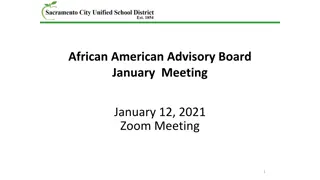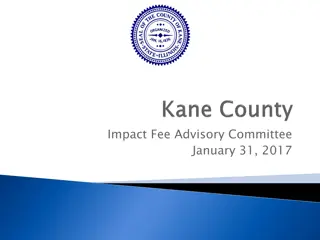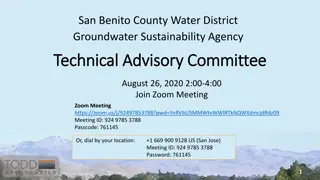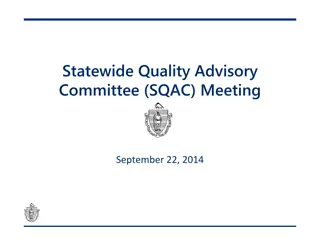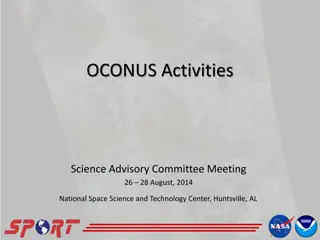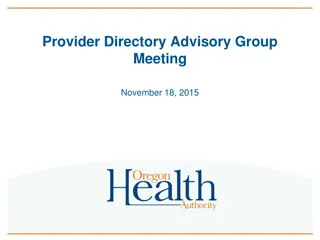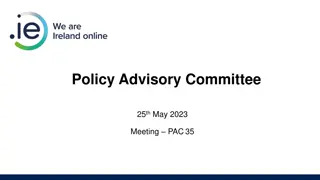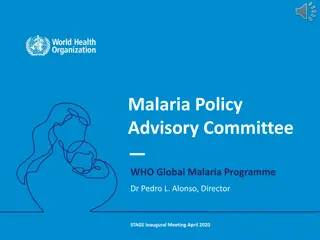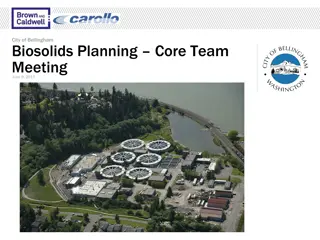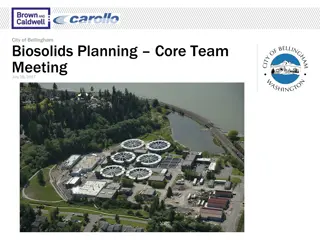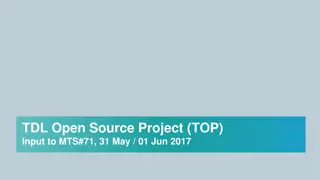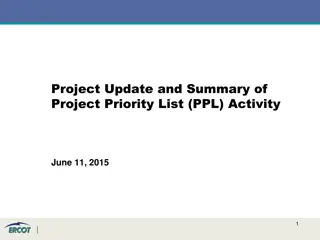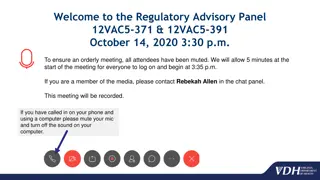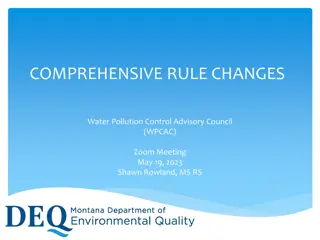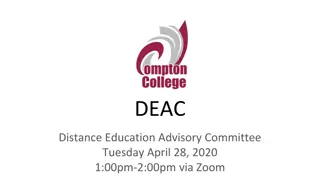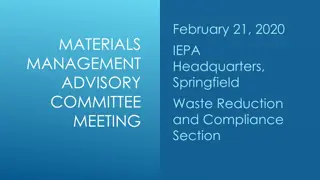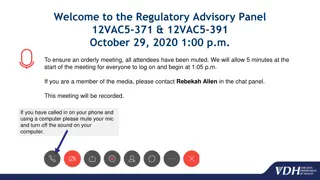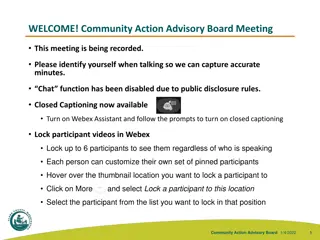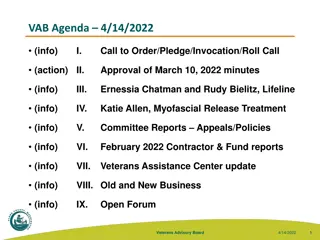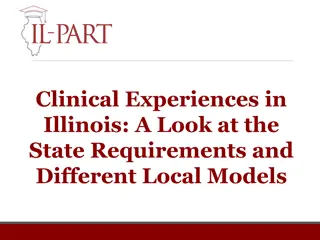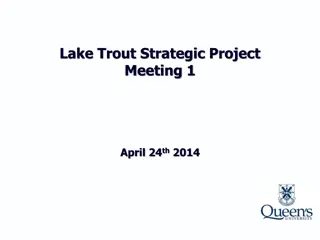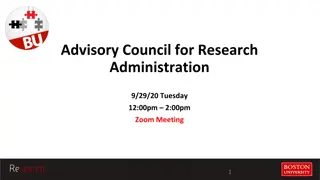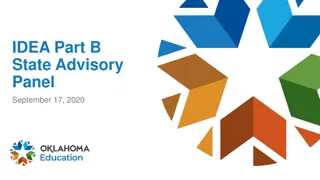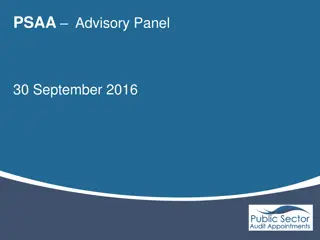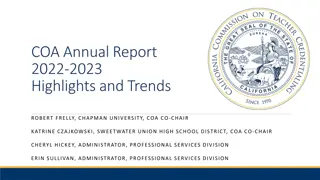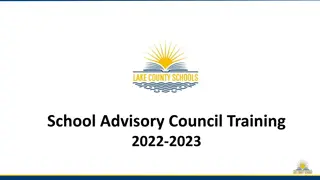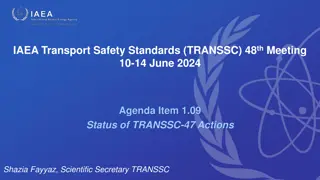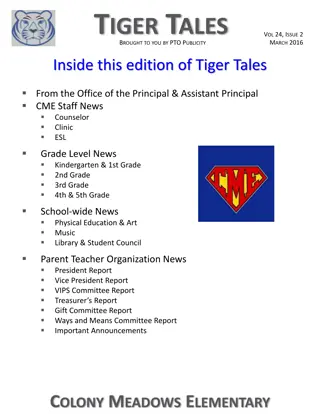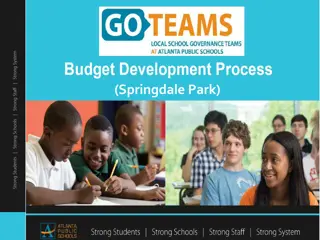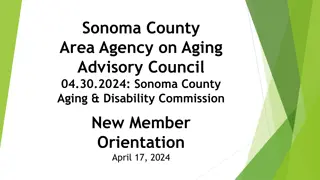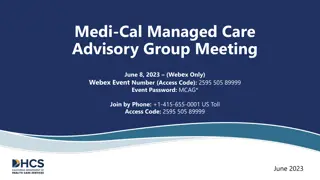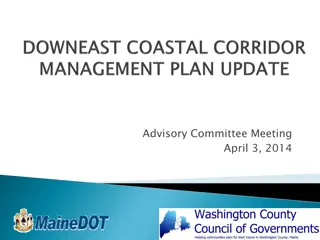Principal Preparation Project Advisory Team Meeting Summary
The Principal Preparation Project Advisory Team convened on January 17, 2018, for Phase 2 of their project. The meeting included introductions, orientation to the day's work, discussions on key success factors, a thought-provoking exercise on poverty and decision-making, and insights on the psychology of scarcity. Participants explored diverse viewpoints and the importance of recognizing both similarities and differences. The meeting aimed to tackle the challenge set by the Commissioner while emphasizing the significance of response over obstacles.
Uploaded on Oct 03, 2024 | 0 Views
Download Presentation

Please find below an Image/Link to download the presentation.
The content on the website is provided AS IS for your information and personal use only. It may not be sold, licensed, or shared on other websites without obtaining consent from the author. Download presentation by click this link. If you encounter any issues during the download, it is possible that the publisher has removed the file from their server.
E N D
Presentation Transcript
Principal Preparation Project Advisory Team (Phase 2) January 17, 2018
Agenda Item #1 Welcome by the Chairs - Suzanne Rosenblith - Reginald Landeau, Jr. - Gladys Cruz Introductions
Agenda Item #2 Getting Oriented to the project and the day s work - Reimbursement - Travel and schedule meeting time(s) - Lunch - Email addresses (OK to share within the Team?) Affinity exercise - Take one post-it - 15 words or less - What is the single biggest hurdle to achieving results we desire? - Post-its collected
Agenda Item #3 Key to our success Turn to neighbors and consider the next slide Discuss whether your views differ and why Be ready to reflect on the take-away and implications for our work
WHICH IS MORE LIKELY TRUE? People are poor because they make bad decisions. People make bad decisions because they are poor.
Possibly it is this . . . NYU professor Kwame Anthony Appiah puts it this way. We must hold 2 ideas in our head at the same time. We are all alike. We are all different. Viewpoints may differ. The challenge is to see beyond differences to identify what we all believe in and value.
Agenda Item #4 What can the psychology of scarcity teach us about the challenge that the Commissioner has given us?
Poverty (& chicken or the egg) is from Sendhil Mullainathan A behavioral economist, Mullainathan focuses on choice. USAFA uses something in pilot training (Gen. Alan Klayton) Obstacles don t define the path. Our response does. Mullainathan explores other phenomena (runway crashes)
What happens when plane landings go awry . . . And what the implications are for our work
In WWII, the U.S. was plagued with unexplained bomber crashes. Often missions ended tragically and at the last possible moment. These involved landings on friendly home airfields located abroad. Inexplicably, pilots retracted the landing gear on touch-down.
The question is, why? Was it carelessness? . . . training? . . . stress? . . . fatigue? . . . distractions?
Ruling out other possibilities, officials finally surmised . . . While stress and lack of sleep can alter cognitive function, . . . the accident source may be linked to cockpit design. With the source understood, solution was easy. Small design tweaks reduced error that leads to tragedy
Possibly it is this . . . To improve things we have tools at our disposal But be cautious when deciding which tool to use A hammer can help build a cathedral or tear it down Focus on the wrong thing can hinder more than help
Or maybe it is this . . . Avoid obvious solutions that focus on the wrong thing Especially if solutions blame those we re trying to help Remember, people don t fail; systems do
Or even possibly this . . . The choice architecture matters. How choices are presented affects decision-making. The goal is simple. Change choices without reducing freedom to choose. Make small changes that yield big improvement.
Source: S. Mullainathan and E. Shafir, Scarcity: The New Science of Having Less and How it Defines our Lives, 2013, p. 167-169 Sendhil Mullainathan MacArthur Fellowship recipient Professor of Behavioral Economics
Agenda Item #5: Logic Model Objective: Understand why we exist, what we do, and how we do it Pitfall: Looking for answers in all the wrong places Three types of wins An assist from Charlie Baum (Starting Point) Data by Source display What is the goal? How do we know what we know about this topic?
Agenda Item #6: How do we achieve consensus At a trial s outset, the judge wants to seat a jury. - The burden of proof is beyond a reasonable doubt. - Thus it matters whether jurors agree to be reasonable. - This is where the judge learns who stays and who goes. - But what does it mean to be reasonable?
Imagine we wanted to describe the ideal learning environment
Ideal learning environment Didactic Structured Self-directed Prescribed paced Self-paced Unstructured Other -directed Experiential
Ideal learning environment Didactic Structured Self-directed Prescribed paced Self-paced Unstructured Other -directed Experiential
Ideal learning environment Didactic Structured Self-directed Prescribed paced Self-paced Unstructured Other -directed Experiential
Ideal learning environment Didactic Structured Self-directed Prescribed paced Self-paced Unstructured Other -directed Experiential
Do I agree to subordinate my self-interest so we can achieve together what no one of can achieve alone? (the aim here is find what you can live with and support, not what you view as ideal)
How will we achieve consensus? Fist to Five (page 52)
Agenda Item #7: Why were here; what we do Objective Understand the mission, boundaries, and questions that animate our work Daphne Koller Four Phases of the Project Work-Streams Goal, Success Criteria, Charge, and Deliverables Folder contents Web site http://www/nysed.gov/schools/principal-project-advisory-team Three thoughts from the 11-stop listening tour (page 37)
2 things matter; one is prominence, the other is resonance. For implementation to succeed we need both. I ll explain. The Quality Review is very prominent (that s good). But it does not resonate with those in the field (that s bad). Prominence means it has a place of importance. It doesn t sit on the shelf. The trick is to make it prominent without contaminating it because it is tied to something that doesn t really lead to growth and improvement. So, the challenge for the state and us is to work together to make sure the Professional Standards for Educational Leaders resonate and are prominent . . . in a healthy way.
I think we need standards, not standardization. If we standardize around one approach a handful of people will fall through the cracks. The exact form of the (district-university) partnership will reflect the kind of community being served. What we need is standards but enough flexibility in the system that we re responsive to the local community s needs.
I want to return to standards and standardization. I ask us to think about and commit to making sure we keep a clear focus on one thing. That is equity. Through the transition, will or how will these standards and/or standardization impact equity? It is easy to say implementation matters. What really matters today is that equity is advanced.
Review our process to reach consensus Fist to Five The goal is to something that every member can live with and support. When co-chairs call a question, members show hands to show support. Those who hold up 3, 4, or 5 fingers support the option 2 fingers means I cannot live with it as is 1 finger means A larger reservation prevents me from supporting it Showing a fist means I cannot support it, as a matter of conscience. Note: Options that are forwarded enjoy consensus support. For these, every Team member shows 3, 4, or 5 fingers. Those who show a fist, 1, or 2 fingers will be asked, What would it take to make this something you can live with and support?
Agenda Item #8: How do we what we do? Operating agreements - Approved minutes reflect official account of our work and our meetings. - Jointly support what we help create. - Consensus recommendations move forward. - Reach consensus using an established process. - Our meetings are held in public but they are not meetings of the public. - No stripes , members and their contributions are valued equally. - OK to miss 1 meeting (we support decisions made in our absence). Fist to Five
Agenda Item #9: Housekeeping How do we avoid mission creep? - Lock in agreements, record in minutes, post prominently. - Cross each bridge once (avoid revisiting decided issues). - Use Parking Lot to trap promising ideas beyond our charge - Avoid trying to cure world hunger Fist to Five
Agenda Item #10: Working lunch Stretch, gather lunch, and visit Be ready to start in about 30 min. When the video ends, we ll re-convene
Agenda Item #11: Consensus-building Take out a single Post-it. Write the letter that best reflects your answer to the following: You re elected to Congress. At the newcomer orientation, the facilitator asks you to respond to a one question. When comes to deciding on an issue, to whom or what will you be loyal? a. Those from your district who voted for you b. All those from your district who voted, including those who did and did not vote for you c. Not just those who voted but everyone in your district with a pulse (even children) d. Your own conscience e. All of humanity f. The planet g. Future generations h. Something else (name it) Collect Post-its. Members turn to neighbors and compare notes (try to reach as much consensus as you can; be ready to report out) As a whole group, see how many and which threesomes could reach agreement In whole group, respond to - What if anything surprised you? - If you weren t surprised, why not? Be ready to reflect on the take-away
More consensus-building Take out a single blank piece of paper. Draw a large pentagon (flat base, peak pointed upward). Place each of the following at one of the vertices. Places a word so its location corresponds to its importance relative to the others. - Truth-telling - Respect for property - Equity - Justice - Respect for life Turn to your two neighbors and compare notes (try to reach as much consensus as you can; be ready to report out) Be ready to name a take-away & implications for our work
Agenda Item #12: Where do we start? Return to Affinity Exercise from opening. Each member used 15 words to describe biggest hurdle to achieving results we desire. Display how results distribute conceptually. Refer to member responses to online MonkeySurvey (page 10) This richness of ideas reflect the range of opinion in our team. The question is, Where do we begin? How do we sort it out? How do we make sense of it in a way that leads to high ground? Distribute MonkeySurvey responses that have been classified Describe who Bob Terry was, what he did, and the framework.
Agenda Item #13: Ladder on the right wall? Work on your own Review 2 areas (principal supervisors & competency based) Categorize entries using mission/power/structure/resource Turn to neighbors to form a group of three. Compare notes. Try to reach as much agreement as you can. Each group of three joins with another group of three. Compare notes. Reach as much agreement as possible Place on chart paper the entries for each of the two areas that are a related to mission. Be ready to report out
Agenda Item #14: Moving into small groups Form 5 small work groups, each focused on aspect of our charge Distribute reading material for each small group Identify the most obvious/important policy implications (in the form of a question) As an example, for competency-based it may be: How will we know changes that are made improve performance of individuals, institutions, and system? How will comparability of judgments across person, institution, and year be achieved? How do we stay legal (IHEs must be accredited) while transitioning to a different set of requirements? How will we support growth of ppl & institutions yet make defensible judgments re quality & adequacy? Within existing resources how can incentives be used to multiple impact and accelerate improvement? How do we decide which changes we propose are uniformly expected across NY and which will be flexible? Record questions on chart paper Discuss (a) options for next steps; (b) help you want from your Phase 2 teammates; (c) how you want to proceed at the next meeting. Be ready to report out to the whole group
Agenda Item #15: Reconvene as whole group Each group report out
Next Meeting Reminder and Adjourn Schedule for future meetings Jan. 31, 2017 Feb. 28, 2017 Mar. 21, 2017 ADJOURN


